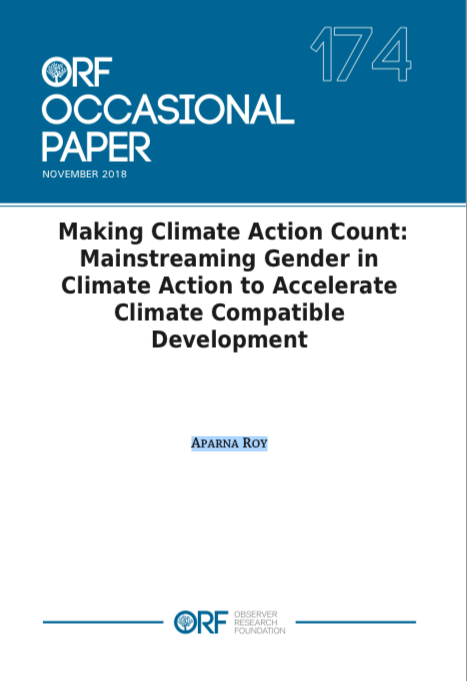Resilience for Sustainable Development in the Lake Chad Basin
The humanitarian crisis in the Lake Chad Basin (LCB) is among the most severe in the world, with more than 10 million people in urgent need of life-saving assistance and protection. As the crisis enters its ninth year, attacks by non-state armed groups remain frequent, and the violent conflict continues to fuel large-scale human suffering, including massive violations of human rights, especially for women and girls, who are often victims of abuse and sexual violence. Communities and individuals in the LCB, especially women, are accustomed to shocks and
Making Climate Action Count: Mainstreaming Gender in Climate Action to Accelerate Climate Compatible Development
The first universal, legally binding global climate accord signed at the 21st session of the Conference of Parties (COP) in Paris in 2015 committed to long-term goals for “holding the increase in the global average temperature to well below 2°C above pre-industrial levels and to pursue efforts to limit the temperature increase to 1.5°C above pre- industrial levels.” However, as world leaders prepare for the Facilitative Dialogue (FD) ahead of COP 24 in December 2018, there is a realisation that fulfilling the climate pledge and ensuring a rapid transition to low- carbon and climate-resilien
Making Climate Action Count: Mainstreaming Gender in Climate Action to Accelerate Climate Compatible Development
The first universal, legally binding global climate accord signed at the 21st session of the Conference of Parties (COP) in Paris in 2015 committed to long-term goals for “holding the increase in the global average temperature to well below 2°C above pre-industrial levels and to pursue efforts to limit the temperature increase to 1.5°C above pre- industrial levels.” However, as world leaders prepare for the Facilitative Dialogue (FD) ahead of COP 24 in December 2018, there is a realisation that fulfilling the climate pledge and ensuring a rapid transition to low- carbon and climate-resilien
Regional Climate Modeling over South America: A Review
This review summarizes the progress achieved on regional climate modeling activities over South America since the early efforts at the beginning of the 2000s until now. During the last 10 years, simulations with regional climate models (RCMs) have been performed for several purposes over the region. Early effortsweremainly focused on sensitivity studies to both physicalmechanisms and technical aspects of RCMs. The last developments were focused mainly on providing high-resolution information on regional climate change.
Pastura natural de Salto (Uruguay): relación con la variabilidad climática y análisis de contextos futuros de cambio climático
En este trabajo se evaluó objetivamente la relación entre la variabilidad del rendimiento de la pastura en el departamento de Salto (Uruguay) y la variabilidad climática. Se analizaron también las posibles implicancias del cambio climático futuro. Se utilizaron datos diarios y mensuales de la estación meteorológica Salto en el período 1961-1990 y un registro de datos experimentales de crecimiento de pastura en el período 1980-1994. Adicionalmente, se emplearon salidas diarias de reanálisis del NCEP y de los Modelos de Circulación General HadCM3 y CSIRO-Mk2 para los escenarios A2 y B2.
Impacto del cambio climático en los oasis del oeste argentino
En Argentina, una de las regiones más vulnerables al Cambio Climático son los oasis productivos del centro-oeste. La actividad agrícola, industrial, la producción de hidroelectricidad y los asentamientos humanos dependen casi exclusivamente del agua proveniente de la fusión de la nieve y de los cuerpos de hielo que se encuentran en la Cordillera de los Andes. la variabilidad de las nevadas (y de los caudales de ríos) es alta, con años de abundancia y de escasez, aunque para la región su tendencia es a disminuir.
Resettlement Processes in Colombia: is this a Measure of Both Adaptation and the Protection of the Human Rights of Communities Affected by Climate Change?
This article presents the deficiencies of the legal system in relation to resettlement of communities as an exceptional measure of climate change adaptation and protection of human rights.
Environmental impacts and simultaneity of positive and negative storm surges on the coast of the Province of Buenos Aires, Argentina
The Argentine shore of the Rio de la Plata estuary and its southwards adjacent maritime front are normally affected by extratropical positive and negative storm surges that affect human activities seriously. Positive surges can raise the water level in the estuary by more than 3m over the predicted tide; thus, flooding the coastal plain where over 13 million people live and causing extensive property damage. Sometimes, there has been loss of life too.
Evaluación de los impactos del cambio climático sobre el ecosistema natural y la biodiversidad.
La biodiversidad y la estabilidad del Iberá están reguladas por el régimen de fluctuación climático- hidrológico que ha determinado distintos modelos de ajuste de las poblaciones animales y vegetales a la periodicidad de la oferta de agua. En este estudio se evaluaron los riesgos para la biota y el paisaje del Iberá que surgen al considerar el cambio global del clima hasta el año 2100.
Efectos de eventos El Niño y La Niña sobre las lagunas del sur de la Región Pampeana (Argentina)
En este trabajo se estudiaron los efectos de eventos El Niño y La Niña sobre la distribución espacio-temporal de las precipitaciones y el agua superficial en el sur de la Región Pampeana, Argentina. Para ello, se analizaron series mensuales de precipitación con el método de Quintiles, el de la tendencia central o la Normal y el Índice Estandarizado de Precipitación. Se evidenció una relación entre la variabilidad pluviométrica con la ocurrencia de eventos El Niño y La Niña. A partir de entonces se analizaron los impactos de los mismos sobre el agua superficial.
Climate downscaling over South America for present- day climate (1970-1989) using the MM5 Model. Mean, Interannual Variability and Internal Variability
Este trabajo evalúa la capacidad del modelo regional MM5 para representar las principales características del clima actual de Sudamérica. Se evalúa la distribución espacial de los valores medios estacionales, la variabilidad interanual y el ciclo anual de la precipitación y la temperatura, así como la variabilidad interna.




